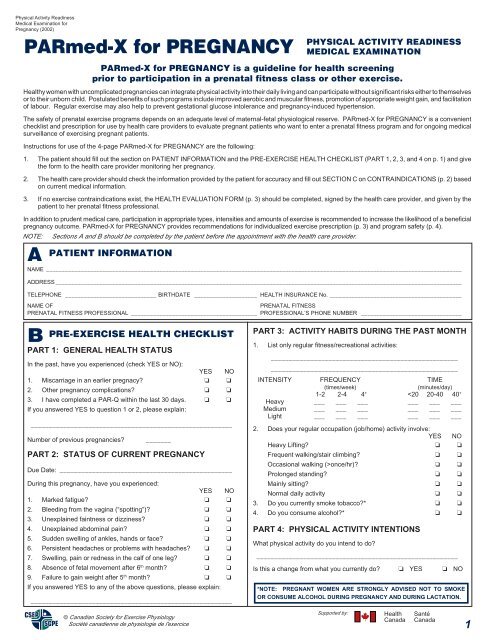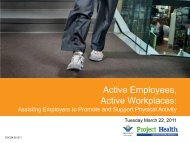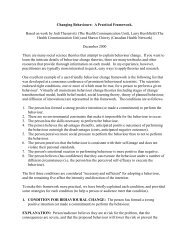PARmed-X for PREGNANCY - PARC - The Physical Activity ...
PARmed-X for PREGNANCY - PARC - The Physical Activity ...
PARmed-X for PREGNANCY - PARC - The Physical Activity ...
- No tags were found...
Create successful ePaper yourself
Turn your PDF publications into a flip-book with our unique Google optimized e-Paper software.
<strong>Physical</strong> <strong>Activity</strong> ReadinessMedical Examination <strong>for</strong>Pregnancy (2002)<strong>PARmed</strong>-X <strong>for</strong> <strong>PREGNANCY</strong><strong>PARmed</strong>-X <strong>for</strong> <strong>PREGNANCY</strong> is a guideline <strong>for</strong> health screeningprior to participation in a prenatal fitness class or other exercise.Healthy women with uncomplicated pregnancies can integrate physical activity into their daily living and can participate without significant risks either to themselvesor to their unborn child. Postulated benefits of such programs include improved aerobic and muscular fitness, promotion of appropriate weight gain, and facilitationof labour. Regular exercise may also help to prevent gestational glucose intolerance and pregnancy-induced hypertension.<strong>The</strong> safety of prenatal exercise programs depends on an adequate level of maternal-fetal physiological reserve. <strong>PARmed</strong>-X <strong>for</strong> <strong>PREGNANCY</strong> is a convenientchecklist and prescription <strong>for</strong> use by health care providers to evaluate pregnant patients who want to enter a prenatal fitness program and <strong>for</strong> ongoing medicalsurveillance of exercising pregnant patients.Instructions <strong>for</strong> use of the 4-page <strong>PARmed</strong>-X <strong>for</strong> <strong>PREGNANCY</strong> are the following:1. <strong>The</strong> patient should fill out the section on PATIENT INFORMATION and the PRE-EXERCISE HEALTH CHECKLIST (PART 1, 2, 3, and 4 on p. 1) and givethe <strong>for</strong>m to the health care provider monitoring her pregnancy.2. <strong>The</strong> health care provider should check the in<strong>for</strong>mation provided by the patient <strong>for</strong> accuracy and fill out SECTION C on CONTRAINDICATIONS (p. 2) basedon current medical in<strong>for</strong>mation.3. If no exercise contraindications exist, the HEALTH EVALUATION FORM (p. 3) should be completed, signed by the health care provider, and given by thepatient to her prenatal fitness professional.In addition to prudent medical care, participation in appropriate types, intensities and amounts of exercise is recommended to increase the likelihood of a beneficialpregnancy outcome. <strong>PARmed</strong>-X <strong>for</strong> <strong>PREGNANCY</strong> provides recommendations <strong>for</strong> individualized exercise prescription (p. 3) and program safety (p. 4).NOTE: Sections A and B should be completed by the patient be<strong>for</strong>e the appointment with the health care provider.APATIENT INFORMATIONNAME ____________________________________________________________________________________________________________________________________ADDRESS _________________________________________________________________________________________________________________________________TELEPHONE _____________________________ BIRTHDATE ____________________ HEALTH INSURANCE No. __________________________________________NAME OFPRENATAL FITNESSPRENATAL FITNESS PROFESSIONAL ________________________________________ PROFESSIONAL’S PHONE NUMBER ________________________________BPRE-EXERCISE HEALTH CHECKLISTPART 1: GENERAL HEALTH STATUSIn the past, have you experienced (check YES or NO):YES NO1. Miscarriage in an earlier pregnacy? ❏ ❏2. Other pregnancy complications? ❏ ❏3. I have completed a PAR-Q within the last 30 days. ❏ ❏If you answered YES to question 1 or 2, please explain:________________________________________________________Number of previous pregnancies? _______PART 2: STATUS OF CURRENT <strong>PREGNANCY</strong>Due Date: ________________________________________________During this pregnancy, have you experienced:YES NO1. Marked fatigue? ❏ ❏2. Bleeding from the vagina (“spotting”)? ❏ ❏3. Unexplained faintness or dizziness? ❏ ❏4. Unexplained abdominal pain? ❏ ❏5. Sudden swelling of ankles, hands or face? ❏ ❏6. Persistent headaches or problems with headaches? ❏ ❏7. Swelling, pain or redness in the calf of one leg? ❏ ❏8. Absence of fetal movement after 6 th month? ❏ ❏9. Failure to gain weight after 5 th month? ❏ ❏If you answered YES to any of the above questions, please explain:________________________________________________________PHYSICAL ACTIVITY READINESSMEDICAL EXAMINATIONPART 3: ACTIVITY HABITS DURING THE PAST MONTH1. List only regular fitness/recreational activities:________________________________________________________________________________________________________INTENSITY FREQUENCY TIME(times/week)(minutes/day)1-2 2-4 4 + once/hr)? ❏ ❏Prolonged standing? ❏ ❏Mainly sitting? ❏ ❏Normal daily activity ❏ ❏3. Do you currently smoke tobacco?* ❏ ❏4. Do you consume alcohol?* ❏ ❏PART 4: PHYSICAL ACTIVITY INTENTIONSWhat physical activity do you intend to do?________________________________________________________Is this a change from what you currently do? ❏ YES ❏ NO*NOTE: PREGNANT WOMEN ARE STRONGLY ADVISED NOT TO SMOKEOR CONSUME ALCOHOL DURING <strong>PREGNANCY</strong> AND DURING LACTATION.© Canadian Society <strong>for</strong> Exercise PhysiologySociété canadienne de physiologie de l'exerciceSupported by:HealthCanadaSantéCanada1
<strong>Physical</strong> <strong>Activity</strong> ReadinessMedical Examination <strong>for</strong>Pregnancy (2002)<strong>PARmed</strong>-X <strong>for</strong> <strong>PREGNANCY</strong>CCONTRAINDICATIONS TO EXERCISE: to be completed by your health care providerAbsolute ContraindicationsDoes the patient have:YES NO1. Ruptured membranes, premature labour? ❏ ❏2. Persistent second or third trimesterbleeding/placenta previa? ❏ ❏3. Pregnancy-induced hypertension or pre-eclampsia ❏ ❏4. Incompetent cervix? ❏ ❏5. Evidence of intrauterine growth restriction? ❏ ❏6. High order pregnancy (e.g., triplets)? ❏ ❏7. Uncontrolled Type I diabetes, hypertension orthyroid disease, other serious cardiovascular,respiratory or systemic disorder? ❏ ❏PHYSICAL ACTIVITY READINESSMEDICAL EXAMINATIONRelative ContraindicationsDoes the patient have:YES NO1. History of spontaneous abortion or premature labourin previous pregnancies? ❏ ❏2. Mild/moderate cardiovascular or respiratory disease(e.g., chronic hypertension, asthma?) ❏ ❏3. Anemia or iron deficiency? (Hb < 100 g/L)? ❏ ❏4. Very low body fatness, eating disorder (anorexia, bulimia)? ❏ ❏5. Twin pregnancy after 28th week? ❏ ❏6. Other significant medical condition? ❏ ❏Please specify: ___________________________________________NOTE: Risk may exceed benefits of regular physical activity. <strong>The</strong> decision tobe physically active or not should be made with qualified medical advice.PHYSICAL ACTIVITY RECOMMENDATION: ❏ Recommended/Approved ❏ ContraindicatedRATE OF PROGRESSION: <strong>The</strong> best time to progress is during the secondtrimester since risks and discom<strong>for</strong>ts of pregnancy are lowest at that time. It isnot advisable to begin a new exercise program or increase the amount ofexercise after the 28 th week. Aerobic exercise should be increased graduallyduring the second trimester from a minimum of 15 minutes per session, threetimes per week (at the appropriate target heart rate or RPE) to a maximum ofapproximately 30 minutes per session, five times per week (at the appropriatetarget heart rate or RPE).WARM-UP/COOL-DOWN: Aerobic activity should be preceded by a brief (10-15 min.) warm-up and followed by a short (10-15 min.) cool-down. Low intensitycalesthenics, stretching and relaxation exercises should be included in the warmup/cool-down.FFREQUENCYBegin at 3 timesper week andprogress tofour or fivetimesper weekIINTENSITYExercise withinan appropriateRPE rangeand/or targetheart ratezonePrescription <strong>for</strong> Aerobic <strong>Activity</strong>TTIMEAttempt 15minutes, evenif it meansreducing theintensity.Rest intervalsmay be helpfulTTYPENon weight-bearingor low-impact enduranceexercise using largemuscle groups (e.g.,walking, stationarycycling, swimming,aquatic exercises, lowimpact aerobics)“TALK TEST” - A final check to avoid overexertion is to use the “talk test”. <strong>The</strong> exercise intensity is excessiveif you cannot carry on a verbal conversation while exercising.PRESCRIPTION/MONITORING OF INTENSITY: <strong>The</strong> best way to prescribeand monitor exercise is by combining the heart rate and rating of perceivedexertion (RPE) methods.TARGET HEARTRATE ZONES<strong>The</strong> heart rate zonesshown below areappropriate <strong>for</strong> mostpregnant women. Workduring the lower end ofthe HR range at the startof a new exerciseprogram and in latepregnancy.Heart RateAge Range< 20 140-15520-29 135-15030-39 130-145≥ 40 125-140RATING OF PERCEIVEDEXERTION (RPE)Check the accuracy of your heart rate target zoneby comparing it to the scale below. A range ofabout 12-14 (somewhat hard) is appropriate <strong>for</strong>most pregnant women.67 Very, very light89 Somewhat light1011 Fairly light1213 Somewhat hard1415 Hard1617 Very hard1819 Very, very hard20<strong>The</strong> original <strong>PARmed</strong>-X <strong>for</strong> <strong>PREGNANCY</strong> was developed by L.A. Wolfe, Ph.D., Queen’s University. <strong>The</strong> muscular conditioning component was developed by M.F.Mottola, Ph.D., University of Western Ontario. <strong>The</strong> document has been revised based on advice from an Expert Advisory Committee of the Canadian Society <strong>for</strong>Exercise Physiology with additonal input from Drs. Wolfe and Mottola, and Gregory A.L. Davies, M.D., Department of Obstetrics and Gynaecology, Queen’sUniversity, 2002.No changes permitted. Translation and reproduction in its entirety is encouraged.Disponible en français sous le titre «Examination medicale sur l’aptitude à l’activité physique pour les femmes enceintes (X-AAP pour les femmes enceintes)»To order additional printed copies of the <strong>PARmed</strong>-X <strong>for</strong> <strong>PREGNANCY</strong>, the <strong>PARmed</strong>-X and/or the PAR-Q, (<strong>for</strong> a nominal charge) contact the:Canadian Society <strong>for</strong> Exercise Physiology185 Somerset St. West, Suite 202, Ottawa, Ontario CANADA K2P 0J2tel.: 1-877-651-3755 FAX (613) 234-3565 www.csep.ca2
○ ○ ○ ○ ○ ○ ○ ○ ○ ○ ○ ○ ○ ○ ○ ○ ○ ○ ○ ○ ○ ○ ○ ○ ○ ○ ○ ○ ○ ○ ○ ○ ○ ○ ○ ○ ○ ○ ○ ○ ○ ○ ○ ○ ○ ○ ○ ○ ○ ○ ○ ○ ○ ○ ○ ○ ○ ○ ○ ○ ○ ○ ○ ○ ○ ○ ○ ○ ○ ○ ○ ○ ○ ○ ○ ○<strong>Physical</strong> <strong>Activity</strong> ReadinessMedical Examination <strong>for</strong>Pregnancy (2002)<strong>PARmed</strong>-X <strong>for</strong> <strong>PREGNANCY</strong>PHYSICAL ACTIVITY READINESSMEDICAL EXAMINATIONPrescription <strong>for</strong> Muscular ConditioningIt is important to condition allmajor muscle groups duringboth prenatal and postnatalperiods.WARM-UPS & COOL DOWN:Range of Motion: neck,shoulder girdle, back, arms,hips, knees, ankles, etc.Static Stretching: all majormuscle groups(DO NOT OVER STRETCH!)EXAMPLES OF MUSCULAR STRENGTHENING EXERCISESCATEGORY PURPOSE EXAMPLEUpper back Promotion of good posture Shoulder shrugs, shoulder blade pinchLower back Promotion of good posture Modified standing opposite leg & arm liftsAbdomen Promotion of good posture, Abdominal tightening, abdominalprevent low-back pain, preventcurl-ups, head raises lying on side or standing positiondiastasis recti, strengthen musclesof labourPelvic floor Promotion of good bladder control, “Wave”, “elevator”(“Kegels”) prevention of urinary incontinenceUpper body Improve muscular support <strong>for</strong> breasts Shoulder rotations, modified push-ups against a wallButtocks, Facilitation of weight-bearing, prevention Buttocks squeeze,standing leg lifts, heel raiseslower limbs of varicose veins✁VARIABLEBody PositionJoint LaxityAbdominal MusclesPosturePrecautions<strong>for</strong>Resistance ExercisePRECAUTIONS FOR MUSCULAR CONDITIONING DURING <strong>PREGNANCY</strong>EFFECTS OF <strong>PREGNANCY</strong>• in the supine position (lying on the back), the enlarged uterusmay either decrease the flow of blood returning from the lowerhalf of the body as it presses on a major vein (inferior vena cava)or it may decrease flow to a major artery (abdominal aorta)• ligaments become relaxed due to increasing hormone levels• joints may be prone to injury• presence of a rippling (bulging) of connective tissue along themidline of the pregnant abdomen (diastasis recti) may be seenduring abdominal exercise• increasing weight of enlarged breasts and uterus may cause a<strong>for</strong>ward shift in the centre of gravity and may increase the arch inthe lower back• this may also cause shoulders to slump <strong>for</strong>wardEXERCISE MODIFICATIONS• past 4 months of gestation, exercises normally done in thesupine position should be altered• such exercises should be done side lying or standing• avoid rapid changes in direction and bouncing during exercises• stretching should be per<strong>for</strong>med with controlled movements• abdominal exercises are not recommended if diastasis rectidevelops• emphasis on correct posture and neural pelvic alignment.Neutral pelvic alignment is found by bending knees, feetshoulder width apart, and aligning pelvis between accentuatedlordosis and the posterior pelvic tilt position.• emphasis must be placed on continuous breathing throughout exercise• exhale on exertion, inhale on relaxation using high repetitions and low weights• Valsalva Manoevre (holding breath while working against a resistance) causes a change in blood pressure and there<strong>for</strong>eshould be avoided• avoid exercise in supine position past 4 months gestation<strong>PARmed</strong>-X <strong>for</strong> Pregnancy - Health Evaluation Form(to be completed by patient and given to the prenatal fitness professionalafter obtaining medical clearance to exercise)I, _____________________________________ PLEASE PRINT (patient’s name), have discussed my plans to participate in physicalactivity during my current pregnancy with my health care provider and I have obtained his/her approval to begin participation.Signed: ___________________________________________(patient’s signature)Date: __________________________________________HEALTH CARE PROVIDER’S COMMENTS:Name of health care provider: _________________________________Address: _________________________________________________________________________________________________________Telephone: _______________________________________________________________________________________________________________________________________________________________________________________________________________________________________________________________________ M.D.(health care provider’s signature)3






